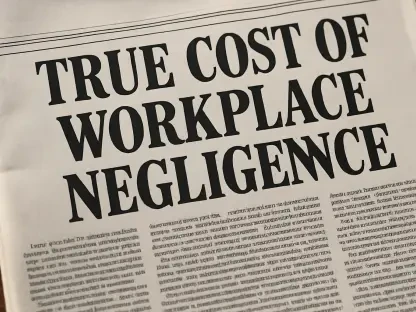In a nation heavily reliant on infrastructure and industrial growth, a staggering reality emerges: the U.S. faces a critical shortage of skilled tradespeople, with millions of positions unfilled across construction, manufacturing, and other vital sectors, costing the economy billions annually in delayed projects and lost productivity. This talent gap poses a significant threat to sustaining essential services and development, as industries struggle to find qualified workers to build, repair, and maintain the backbone of American society. The growing concern over this shortage highlights a deeper issue of perception and engagement, particularly among younger generations. This analysis delves into generational differences in attitudes toward trade careers, the barriers preventing younger workers from entering these fields, and actionable strategies to bridge the gap.
The State of Skilled Trades in America
Public Perception and Valuation of Blue-Collar Jobs
A recent comprehensive survey of over 2,200 U.S. adults reveals a strong consensus on the importance of skilled trades, with 91% of respondents recognizing blue-collar jobs as equally crucial to the economy as white-collar roles. Despite this acknowledgment, 86% believe that trade careers are undervalued within educational systems, often overshadowed by an emphasis on traditional academic paths. This disconnect between recognition and prioritization underscores a systemic challenge in promoting these essential professions.
The shortage of tradespeople has tangible consequences in critical industries such as manufacturing and construction. Reports indicate that project timelines are frequently delayed, and budgets are strained due to the lack of qualified workers, hampering progress on infrastructure upgrades and new developments. This gap not only affects individual companies but also ripples through the broader economy, stalling growth in key areas.
Addressing this issue requires a shift in how society and educational institutions frame the value of skilled trades. The widespread agreement on their importance must translate into concrete actions to elevate their status and ensure they are seen as viable, respected career paths for future generations.
Generational Divide in Attitudes Toward Trade Careers
Significant differences exist across generations when it comes to enthusiasm for skilled trades as a career choice. Data shows that 59% of baby boomers view trades as offering the best job opportunities, a stark contrast to just 38% of Gen Z, 40% of millennials, and 45% of Gen X. This generational divide points to varying levels of awareness and cultural influence shaping career decisions.
Societal pressures play a substantial role in steering younger generations away from trade careers. The push for college degrees often overshadows vocational training, with many schools lacking programs or counseling that highlight the benefits of trades. As a result, many young individuals remain unaware of the potential for stable, well-paying jobs in these fields.
Additionally, the narrative around blue-collar work as less prestigious or physically demanding deters interest among younger cohorts. Changing these perceptions necessitates early exposure through career fairs, mentorships, and updated curricula that showcase the modern, technology-driven nature of many trade roles, aligning them with the interests of tech-savvy generations.
Barriers Facing Younger Generations
Gen Z’s Hesitancy and Misconceptions
Gen Z exhibits notable reluctance toward pursuing skilled trades, with only 36% strongly agreeing that these careers offer a fast, affordable path to rewarding work, a sentiment more prevalent among older generations. Concerns about lower prestige compared to white-collar jobs heavily influence their hesitancy, as societal norms often equate professional success with office-based roles.
Further compounding this issue are fears of job insecurity and automation, with many young individuals worrying that trade roles may become obsolete or lack long-term stability. Perceptions of limited career flexibility also deter interest, as Gen Z often prioritizes adaptability and diverse opportunities in their professional journeys, viewing trades as restrictive in comparison.
These misconceptions stand in contrast to broader barriers identified in surveys, such as the overwhelming societal push for higher education over vocational paths. Addressing Gen Z’s specific doubts requires targeted efforts to debunk myths, emphasizing the durability of trade skills in an evolving economy and showcasing pathways for advancement within these fields.
Real-World Implications of the Talent Gap
The reluctance of younger workers to enter skilled trades intensifies existing shortages, leading to significant operational challenges in key industries. For instance, construction projects across the country face delays due to insufficient staffing, driving up costs and hindering timely completion of critical infrastructure like highways and public facilities.
Beyond individual projects, the economic ripple effects are profound, as an understaffed skilled workforce undermines national growth and competitiveness. Businesses struggle to meet demand, while communities suffer from slower development and maintenance of essential services, highlighting the urgency of addressing this gap.
The broader implications extend to innovation and resilience, as the absence of skilled tradespeople limits the ability to adapt to new technologies and sustainable practices in industries. This underscores the need for immediate action to attract and train new talent, ensuring the stability of these foundational sectors for years to come.
Expert Insights on Addressing the Gap
Industry leaders emphasize the rewarding dimensions of trade careers, pointing to elements like teamwork, leadership opportunities, and significant growth potential as key attractions. A retired senior executive highlighted in recent discussions notes that while challenges exist, the personal and professional fulfillment derived from hands-on work often surpasses expectations, offering a sense of tangible impact.
Balancing this optimism with realism is essential, as romanticizing the field can lead to disillusionment. Experts advocate for honest portrayals that acknowledge physical demands and economic fluctuations while showcasing success stories of tradespeople who have built thriving careers through dedication and skill development.
Educational outreach forms a cornerstone of expert recommendations, urging schools and businesses to collaborate on initiatives that expose students to trade careers early on. By integrating real-life examples and mentorship from current professionals, the narrative can shift to one of opportunity and respect, encouraging more young individuals to consider these paths seriously.
Future Outlook for Skilled Trades
Attracting Gen Z to skilled trades hinges on innovative strategies such as employer-led training programs and paid internships that provide hands-on experience without financial burden. Apprenticeships and scholarships further sweeten the deal, creating accessible entry points and building robust talent pipelines for industries in desperate need of workers.
Reframing skilled trades as respected, future-proof careers with competitive pay and meaningful purpose offers another powerful avenue for change. Human Resources departments play a pivotal role in this transformation, identifying skill shortages as operational risks and advocating for strategic investments in training to mitigate long-term impacts on business continuity.
Challenges persist, particularly in dismantling deep-seated societal biases that prioritize academic over vocational achievements. However, positive outcomes are within reach, as a revitalized workforce could meet national demand, drive economic stability, and restore balance to labor markets through concerted efforts from all stakeholders.
Conclusion and Call to Action
Reflecting on the critical discussions around skilled trades, it becomes evident that generational perception gaps and talent shortages pose significant hurdles to economic vitality. The undervaluation of these essential roles within educational systems has long contributed to a dwindling workforce, as younger generations gravitate away from such paths. Overcoming these challenges demands a unified approach, and the insights gathered point toward transformative potential. Businesses, educators, and policymakers are urged to forge partnerships that prioritize vocational training, reshape outdated narratives, and invest in accessible programs like apprenticeships. By highlighting modern success stories and the evolving, technology-driven nature of trades, a new generation can be inspired to step into these vital roles, ensuring a stronger, more resilient future for the nation’s infrastructure and industries.









